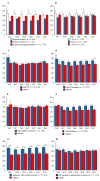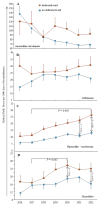Antibiotic Consumption 2017-2022 in 30 Private Hospitals in France: Impact of Antimicrobial Stewardship Tools and COVID-19 Pandemic
- PMID: 38391566
- PMCID: PMC10886305
- DOI: 10.3390/antibiotics13020180
Antibiotic Consumption 2017-2022 in 30 Private Hospitals in France: Impact of Antimicrobial Stewardship Tools and COVID-19 Pandemic
Abstract
Our aim was to determine the impact of antimicrobial stewardship tools (ASTs) and the COVID-19 pandemic on antibiotic consumption (AC). We used the national software Consores® to determine AC in DDD/1000 days of hospitalization from 2017 to 2022 in voluntary private hospitals in France. The ASTs considered were: 1. internal guidelines; 2. the list of antibiotics with restricted access; 3. the presence of an antibiotic referent or 4. an ID specialist; and 5. proof of an annual meeting on antimicrobial resistance. Institutions with dedicated units for COVID-19 patients were specified. In 30 institutions, the total AC varied from (means) 390 to 405 DDD/1000 DH from 2017 to 2022. Fluoroquinolones and amoxicillin/clavulanate consumption decreased from 50 to 36 (p = 0.003) and from 112 to 77 (p = 0.025), respectively, but consumption of piperacillin/tazobactam increased from 9 to 21 (p < 0.001). Over the study period, 10 institutions with ≤2 AST had lower AC compared to 20 institutions with ≥3 AST (p < 0.01). COVID-19 units opened in 10 institutions were associated with a trend toward higher macrolide consumption from 15 to 25 from 2017 to 2020 (p = 0.065) and with an acceleration of piperacillin/tazobactam consumption from 2020 to 2022 (p ≤ 0.003). Antibiotic consumption in 30 private hospitals in France was inversely related to the number of AST. The COVID-19 pandemic was associated with limited impact on AC, but special attention should be paid to piperacillin/tazobactam consumption.
Keywords: COVID-19; antibiotic consumption; antimicrobial stewardship; defined daily doses; tools.
Conflict of interest statement
The authors declare no conflict of interest.
Figures



Similar articles
-
Is Antimicrobial Stewardship Policy Effectively Implemented in Polish Hospitals? Results from Antibiotic Consumption Surveillance before and during the COVID-19 Pandemic.Antibiotics (Basel). 2024 Jul 10;13(7):636. doi: 10.3390/antibiotics13070636. Antibiotics (Basel). 2024. PMID: 39061318 Free PMC article.
-
Correlation between antibiotic consumption and resistance of bloodstream bacteria in a University Hospital in North Eastern Italy, 2008-2014.Infection. 2017 Aug;45(4):459-467. doi: 10.1007/s15010-017-0998-z. Epub 2017 Mar 6. Infection. 2017. PMID: 28265870
-
Antimicrobial Stewardship in COVID-19 Patients: Those Who Sow Will Reap Even through Hard Times.Antibiotics (Basel). 2023 Jun 4;12(6):1009. doi: 10.3390/antibiotics12061009. Antibiotics (Basel). 2023. PMID: 37370328 Free PMC article.
-
Higher third-generation cephalosporin prescription proportion is associated with lower probability of reducing carbapenem use: a nationwide retrospective study.Antimicrob Resist Infect Control. 2018 Jan 22;7:11. doi: 10.1186/s13756-018-0302-8. eCollection 2018. Antimicrob Resist Infect Control. 2018. PMID: 29387345 Free PMC article.
-
How to improve the collection and analysis of hospital antibiotic consumption: preliminary results of the ConsoRes software experimental implementation.Med Mal Infect. 2012 Apr;42(4):154-60. doi: 10.1016/j.medmal.2012.02.006. Epub 2012 Mar 15. Med Mal Infect. 2012. PMID: 22424796
Cited by
-
Kinetic Patterns of Antibiotic Consumption in German Acute Care Hospitals from 2017 to 2023.Antibiotics (Basel). 2025 Mar 18;14(3):316. doi: 10.3390/antibiotics14030316. Antibiotics (Basel). 2025. PMID: 40149126 Free PMC article.
-
Impact of the COVID-19 Pandemic on Inpatient Antibiotic and Antifungal Drug Prescribing Volumes in Germany.Antibiotics (Basel). 2024 Sep 3;13(9):837. doi: 10.3390/antibiotics13090837. Antibiotics (Basel). 2024. PMID: 39335010 Free PMC article.
References
-
- Core Elements of Hospital Antibiotic Stewardship Programs: Antibiotic Use|CDC. [(accessed on 1 January 2020)]; Available online: https://www.cdc.gov/antibiotic-use/core-elements/hospital.html.
-
- Roger P.-M., Espinet A., Ravily D., Meyer M.-J., Moll F., Montera E., Rancezot A., Dautezac V., Pantaloni O. Simplified therapeutic guidelines: The main tool of antimicrobial stewardship programs associated with optimal antibiotic therapy. Eur. J. Clin. Microbiol. Infect. Dis. 2022;41:375–383. doi: 10.1007/s10096-021-04317-z. - DOI - PubMed
-
- Tamma P.D., Avdic E., Keenan J.F., Zhao Y., Anand G., Cooper J., Dezube R., Hsu S., Cosgrove S.E. What is the more effective antibiotic stewardship intervention: Preprescription authorization or postprescription review with feedback? Clin. Infect. Dis. 2017;64:537–543. doi: 10.1093/cid/ciw780. - DOI - PMC - PubMed
LinkOut - more resources
Full Text Sources
Research Materials

